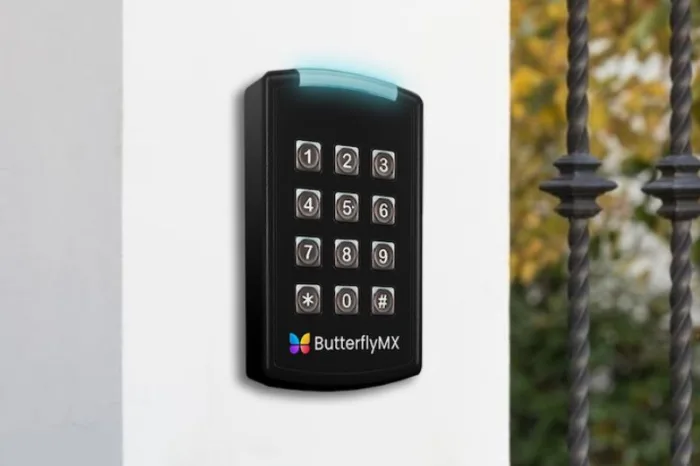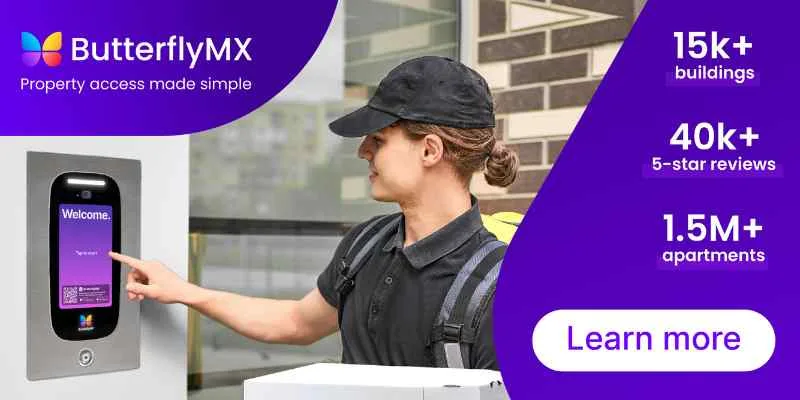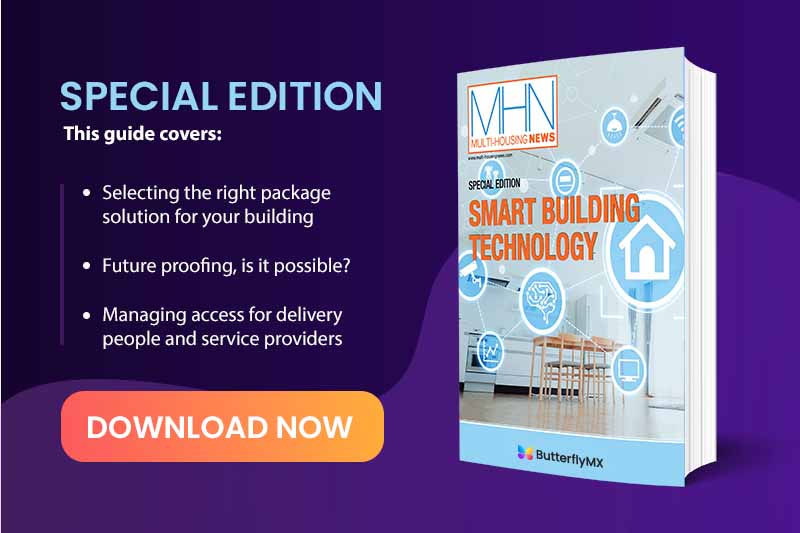Key takeaways
- Physical security involves protecting tangible assets from various threats, requiring a balance between security needs and convenience for occupants.
- Threats that security helps protect against include theft, vandalism, intruders, and natural disasters.
- Key components of physical security include security cameras, access control, and auditing, which must work in tandem to ensure property safety.
- Consider cloud-based systems, a mobile app, and third-party integrations when choosing a security solution.

From security guards to alarms to motion detectors, there are many ways to establish physical security on your property. But it comes with a lot of nuances. So, it’s your job to balance security needs with the convenience and ease of access people expect from today’s properties.
For those reasons, this guide will explain physical security and how it works and provide real-world examples. We will also cover best practices, common threats, and measures you can implement. Most importantly, we’ll show you what to consider when choosing a security solution.
This post covers:
- What is physical security?
- How physical security works
- Physical security examples
- Best practices for physical security
- Common physical security threats
- Physical security measures
- How to choose the best physical security system
What is physical security?
Physical security is protecting individuals, properties, and resources from potential harm. This involves a comprehensive approach to safeguarding tangible assets from various physical threats, such as natural disasters or criminal activity.
Effective security measures combine multiple strategies to ensure the safety and integrity of assets and people. Above all, adequate security reduces the time, money, and resources spent to repair damages from physical threats.
What are the 3 important components of physical security?
Physical security has three important components: surveillance, access control, and testing.
Each component of physical security needs the other to protect a building successfully. With the right combination of hardware and staff effort, you’ll ensure that your property delivers on all three components.
However, no component can fully function without help from the others. If you only have a video surveillance system, how can you ensure that everybody on your property is supposed to be there without any access control measures? Likewise, how do you ensure that your system has no blind spots or weaknesses if you don’t test it?
This is why you must ensure your property is rounded out with an equal focus on access control, testing, and surveillance.
What are the 5 levels of physical security?
The five levels of physical security are:
- Minimum
- Low-level
- Medium
- High-level
- Maximum
As you go up levels, verifying an authorized tenant becomes more secure but more complicated and time-consuming. Higher levels also imply a larger presence of existing security hardware and more intensive procedures for staff.
Each level of physical building security is appropriate in different contexts.
For example, many American homes have minimum security because they use one defensive measure: your standard lock and key. But on the other end of the scale are maximum-security areas like prisons or nuclear power plants!
Depending on the property type, you’ll want to choose a low-, medium-, or high-security level as an owner or operator.
Pro tip: Opt for hardware that meets OSDP (Open Supervised Device Protocol) standards to maximize security.
How physical security works
Fences and locks are important physical security devices but only represent one aspect of protecting properties.
Physical security boils down to two main responsibilities:
You must keep unauthorized intruders out while protecting verified tenants, staff, and guests.
Remember how different areas of your building will have different levels of security? That choice isn’t just theoretical. It’ll also influence choices like the type of locks you use on doors — for example, whether you choose a fail-safe or fail-secure lock that offers different levels of security during a power outage.
Maintaining high physical building security is always offset by two major factors: convenience and cost.
In addition to physical security, property owners and managers must consider the tradeoff of security vs. convenience and decide which areas to prioritize. They must also consider the most cost-effective way to provide physical security.
Physical security examples
Physical security is a wide-ranging field with examples from motion sensors to key card systems.
But every security system has one of these two factors in common: it makes it harder for an intruder to get into a building and makes it easier for your staff members to detect an intruder if they’re already inside.
Because each system has its own pros and cons, real estate professionals often choose more than one.
Examples of physical security systems include:
1. Perimeter security
Perimeter security systems are physical barriers that protect against intruders who force their way onto your property.
Examples of perimeter security include:
- Gates
- Fences
- Reinforced glass
- Garage doors
2. Access control
Access control systems protect against intruders who would enter your building without authorization.
There are many types of access control systems. The primary difference between them is the type of credential tenants use to gain access.
Examples of physical access control systems include:
- Locks and keys
- Key fob systems
- Biometric readers that scan a resident’s eye or face
- Intercom systems
Pro tip: Integrate your access control system with a front desk station. That way, you can easily unlock any door or gate by pressing a single button on your computer. Additionally, enhance security by viewing live video feeds of all entry activity from your property’s front desk.
3. Surveillance
Surveillance systems are another line of defense that can spot intruders who might have bypassed your physical access measures. Or, they might automatically detect natural disasters and issue warnings if they do.
Examples of surveillance systems include:
- Security cameras
- Fire alarms
- Motion detectors
A staff member or a guard might man a surveillance system. Or an AI security system might analyze a camera feed to detect intruders automatically.
The role of staff members in physical security
You might be asking: What is the role of staff members when enforcing physical security?
A staff member can contribute to all three aspects of physical security (perimeter security, access control, and surveillance).
In the past, property managers often depended on staff members to handle duties like patrolling the property or signing guests in with a pen and paper. However, security-related tasks are monotonous and inefficient when securing your entire property.
For example, say you have a guard on patrol. Wouldn’t investing in a CCTV system, allowing that same guard to oversee your entire property instead of just the immediate vicinity, be more efficient?
Supplementing your staff’s security activities with security technology will benefit you, your staff, and your residents.
Best practices for physical security
You can integrate many physical security best practices, but choosing only one isn’t sufficient. Instead, it would be best to implement as many as possible to maximize the security of your property, employees, and tenants.
Best practices for physical security include:
- Annual security audit: The first step you can take in improving your property’s security is learning which areas need improvement. So, reach out to a security professional for a complete property inspection. They’ll provide a report on what you should improve and how to implement it.
- Implement access control: Access control varies widely depending on the property, but it serves as an effective way to prevent security issues. Regardless of the type of access control solution you implement — from security turnstiles to intercoms to gate keypads — restricting access to certain areas of the property ensures that only authorized people can navigate the building.
- Add exterior lighting: Installing exterior lighting around your property makes it easy to keep potential intruders away. Consider motion sensor lights to save on energy costs and effectively scare away intruders at night.
- Invest in video surveillance: The ability to catch evidence of a crime on camera is powerful. However, the presence of commercial security cameras and appropriate signage is also very effective in deterring threats, especially for businesses with offices full of high-value products.
- Secure parking areas: Parking lots and garages are common places for burglars and thieves to access property they shouldn’t. You could implement several physical security methods, including cameras, gates, access control systems, security guards, and more.
Common physical security threats
The most common physical security threats include:
Intruders
Residents consider intruders one of their greatest threats. Intruders can range from casual trespassers to individuals with harmful intentions. Fortunately, various security solutions can delay or even entirely stop an intruder. Installing fences or outdoor motion sensor alarms can deter an intruder before they even set foot inside your building.
Thieves
The most common type of theft that property managers must deal with is the porch pirate — a thief that steals unattended packages that a delivery courier leaves in a lobby or near the front door. Porch pirates cost residents billions of dollars every year.
Protecting your tenants’ packages is an important part of your job in a world where online deliveries are prevalent. Installing secure package lockers, implementing access control systems for delivery areas, and utilizing video surveillance can help deter theft and protect deliveries.
Natural disasters
Natural disasters such as floods, earthquakes, hurricanes, and fires threaten physical security. These events can disrupt power supplies, damage infrastructure, and incapacitate security systems.
Having a disaster preparedness plan is crucial to maintain maximum physical security. This way, employees or residents understand what to do in an emergency. Moreover, regularly inspect and maintain structural integrity and train staff on emergency procedures to minimize risks and ensure a swift response during disasters.
Vandalism
Vandalism can result in significant property damage and create an unsafe environment for residents. It often includes graffiti, broken windows, and damage to communal areas. To combat vandalism, consider implementing lighting in vulnerable areas and installing security cameras to capture criminal activity. Community engagement programs and rapid response to vandalism incidents can deter future occurrences.
Internal threats
Not all threats come from outside. Internal threats include disgruntled employees, contractors, or even residents who may cause harm intentionally or unintentionally. Implementing access control and fostering a culture of security awareness among residents and staff can help mitigate internal threats.
Terrorism
Although less common, terrorism is a severe threat that targets both individuals and infrastructure. Measures to counteract this include rigorous access control, regular security training for identifying suspicious activities, and collaboration with local law enforcement and security agencies. High-risk areas may also benefit from blast-resistant materials and designs to minimize the impact of any potential attacks.
Physical security measures
Enhancing physical security on your property involves implementing a range of measures to protect individuals, assets, and infrastructure from potential threats.
Here are some measures to consider:
- Assessment and consultation
- Physical barriers and deterrents
- Surveillance and monitoring
- Access control systems
- Environmental design
- Emergency preparedness
- Regular audits and updates
Assessment and consultation
You can improve your property’s security by calling specialists who will assess your property, provide expert recommendations and advice, and point out blind spots you might have missed. More specifically, you might consider hiring either a physical security consultant or a security integrator.
Physical security consultant
Physical security consultants can help revamp your entire property to prioritize security. A consultant will first fully assess your property. Then, they’ll work with you to determine which security systems you should add or remove. If any existing procedures need updating, they’ll also train your staff on the latest physical security best practices.
However, a consultant is good for more than just recommendations. Using their existing connections with security vendors, they can help you hand-select the equipment and tactics that will best fit your property’s unique needs. They can also connect you to a vetted security system installer.
Usually, you should hire physical security consultants if you want to restructure your existing security systems from the top down. However, this can be expensive, so another option is hiring somebody who can work with your existing systems: a security integrator.
Security integrator
If you want to combine management systems and practices for your existing equipment, a security integrator is right for you. Unlike a physical security consultant, security integrators are less interested in installing new hardware and more focused on improving and streamlining your existing systems.
With the help of today’s Internet of Things (IoT) technology, you’ll be able to integrate different security systems together. Access control integration will save time and money while providing your tenants with heightened security.
Consider how many different systems you currently deal with. These systems were probably installed at different times. For example, you might have installed a keypad at your gate while using a smart lock to secure your front door.
Using these two different access control systems might mean having to administer two separate databases and issuing two different sets of credentials. By hiring someone to perform a security system integration, you can use the same database to control multiple systems.
Physical barriers and deterrents
Implement physical barriers such as fences, gates, and bollards to prevent unauthorized access. Combine these with deterrents like signage, lighting, and landscaping to make your property less attractive to potential intruders.
Surveillance and monitoring
Install a comprehensive surveillance system that includes CCTV cameras, motion detectors, and alarm systems. Ensure these systems are monitored in real-time, and that recorded footage is stored securely for future reference.
Access control systems
Deploy advanced access control systems to manage who can enter your property and specific areas. Many options, such as key cards, mobile access solutions, and vehicle readers, are available. By choosing the right solution, you can benefit from a comprehensive access control platform remotely managed from your desktop or mobile app.
Learn how to increase your NOI with access control:
Environmental design
Incorporate Crime Prevention Through Environmental Design (CPTED) principles. This involves designing the physical environment to deter criminal activity, such as through strategic placement of lighting, natural surveillance opportunities, and clear boundaries.
Emergency preparedness
Develop and regularly update an emergency response plan that includes procedures for dealing with various physical threats, such as fires, natural disasters, and security breaches. What’s more, you should conduct regular drills and training sessions for staff to ensure they are prepared.
Regular audits and updates
Conduct regular security audits to identify vulnerabilities and areas for improvement. Stay informed about the latest security technologies and practices, and update your systems and procedures accordingly.
How to choose the best physical security system
While every property has different security needs, there are a few aspects of any physical security system company that you’ll find handy.
Choose a security system that has:
Cloud-based software
When your security system is cloud-based, that means that you can manage it from anywhere and from any device — even if you’re off-site.
Legacy systems without cloud-based software force a staff member to manage everything on the premises. Additionally, they’re usually limited to one central console that every staff member must share.
In contrast, cloud-based software supports multiple remote log-ons. That means that staff members can update access permissions and tackle issues as soon as they arise.
A mobile app
Now that smartphones are in everybody’s pockets, mobile apps are the next big thing in physical security.
The best security systems maximize convenience, and the best apps empower tenants to open doors, manage access, and send Visitor Passes to guests — all from their phones.
Smartphone-based access control also eliminates the need for you to run wiring between hardware from every access point to your front door. As a result, you’ll save thousands on installation and maintenance costs.
Integrations
Integrations are a property manager’s best friend.
By integrating one security system with other software and hardware on your property, you’ll cut down on administrative time and decrease the chances of error.
For example, consider the ButterflyMX smart video intercom, which integrates with your property management software. Most intercoms require your staff members to manually update the tenant directory and access permissions in multiple systems when residents move in or out. But because the ButterflyMX intercom automatically updates whenever you update your rent roll, that’s one more administrative burden you’ve just eliminated.
Delivery solutions
Managing deliveries is one of the most important parts of your job. You have to ensure that a delivery courier can enter your building quickly and conveniently while ensuring that they don’t overstay their welcome and access any unauthorized areas.
The best physical security systems empower tenants to issue one-time Delivery Passes to their couriers. This way, you maintain high levels of security while simplifying the delivery process for both courier and resident.








